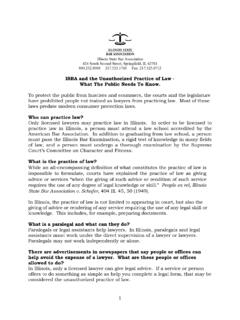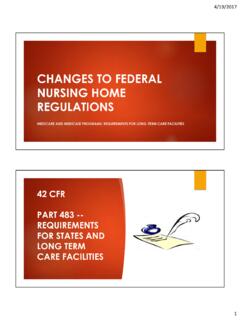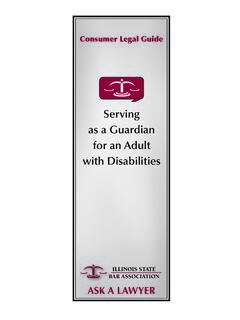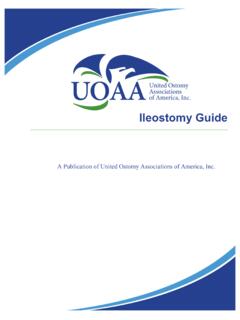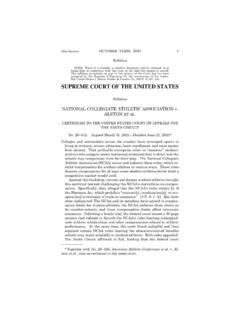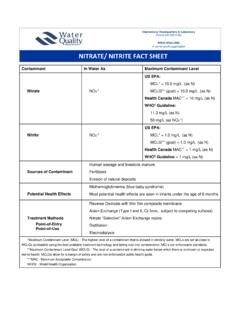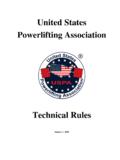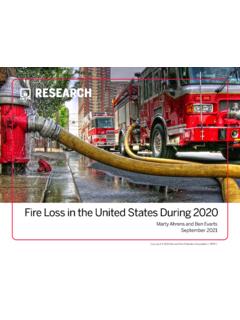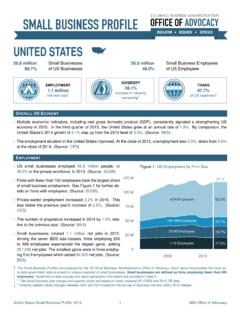Transcription of UNDERSTANDING THE ILLINOIS CONSTITUTION
1 UNDERSTANDING THEILLINOISCONSTITUTION2001 EDITIONBy Frank KopeckyandMary Sherman HarrisUNDERSTANDING THEILLINOISCONSTITUTION2001 EDITIONBy Frank KopeckyandMary Sherman HarrisOriginally published by the ILLINOIS Bar FoundationSpringfield, IllinoisCopyright, 1986 ILLINOIS Bar FoundationRevised and reprinted, 2000 ILLINOIS LEARN ProgramiChapter 1 ILLINOIS CONSTITUTION : Its Purpose and History ..1 Chapter 2 Political Theory and the CONSTITUTION .. 9 Chapter 3 Legislative Powers .. 13 Chapter 4 Executive Powers .. 22 Chapter 5 Judicial Powers .. 29 Chapter 6 Bill of Rights .. 37 Chapter 7 Local Government and Education .. 45 Chapter 8 Finances, Taxes and General Government .. 53 Chapter 9 Change and the CONSTITUTION .. 58 62 Glossary .. 64A List of Web Sites to Try .. 66iiCONTENTSThe ILLINOIS CONSTITUTION of 1970 is the basic governing law of ILLINOIS and provides theframework for state and local government. All students in the state are required to have knowl-edge of the ILLINOIS CONSTITUTION .
2 This book, UNDERSTANDING the ILLINOIS CONSTITUTION , has beenwritten to provide a concise resource for study of the governing structure and the constitu-tional history of ILLINOIS . Major funding for publication and distribution of the book has beenprovided by The ILLINOIS Bar Foundation and the ILLINOIS LEARN Program; both are charitablebranches of the ILLINOIS State Bar Association. The book describes the provisions of the CONSTITUTION , as well as its history and politicaltheory. A short bibliography and glossary are included. The actual language of the constitu-tion appears at various points throughout the text but has not been reproduced in completeform. The entire text of the CONSTITUTION is found in the ILLINOIS Compiled Statutes or in theHandbook of ILLINOIS Government (available from the ILLINOIS Secretary of State). UNDERSTANDING the ILLINOIS Constitutionis designed for use as a supplemental text in his-tory or government courses.
3 It was written with the assumption the reader would have somefamiliarity with the united States CONSTITUTION . Throughout the text, references and compar-isons are made to the united States CONSTITUTION ; therefore, though not essential, the UnitedStates CONSTITUTION should be studied prior to reading the book. The book provides several weeks worth of teaching material, more than can be used in thetypical course. If there is insufficient time to read all nine chapters in the first section, severalmay be omitted. Chapters VII and VIII, dealing with local government and revenue, may bedeleted without dramatically diminishing the book s purpose of teaching the structure ofIllinois government. Chapter II on political theory and chapter VI on the Bill of Rights may alsobe deleted. Chapters I, III, IV, V, and IX will give the reader an UNDERSTANDING of the constitu-tional history of ILLINOIS and the basic framework of ILLINOIS government.
4 The goal of the authors, the ILLINOIS Bar Foundation, and the ILLINOIS LEARN Program, wasto provide a lasting contribution to the citizens of the state. It is hoped this book will be usedto develop and educate the citizens on constitutional principles. The key principle of govern-ment contained in our federal and state constitutions is that of a government by the consent ofthe governed. To make this principle work, the governed must actively participate in the affairsof the paraphrase Abraham Lincoln s Gettysburg Address: ..government of the people, bythe people, for the people, shall soon perish from the earth if the people do not undertake theircivic duty to participate. Our ILLINOIS CONSTITUTION reminds us of this fact in the Bill of Rightsarticle (article 1, section 23) by stating that the blessing of liberty cannot endure unless thepeople recognize their corresponding individual obligations and responsibilities.
5 The ILLINOIS Bar Foundation and the ILLINOIS LEARN Program provided major funding tothe authors and the Center for Legal Studies at the University of ILLINOIS -Springfield to writeand revise this book. The support, interest and assistance of the ILLINOIS Bar Foundation and theIllinois LEARN Program, their officers and board of directors, is gratefully acknowledged. Thanks are also extended to: The ILLINOIS State Board of Education and Ann Pictor. SherrieGood, Denise Baer, Eileen Karam and Murray Seltzer supplied editorial and research assis-tance. Dennis Rendleman, Isolde Davidson, Donna Schechter of the ILLINOIS State BarAssociation, provided administrative and technical assistance and Dru Fernandes providedgraphics and design. Beverly Dixon and Carol Spence, secretaries for the Center for LegalStudies at the University of ILLINOIS at Springfield, revised drafts of the book. Thank people of the state of ILLINOIS , through theIllinois CONSTITUTION of 1970, created a governmentalstructure to manage the public activities of the primary purpose of the CONSTITUTION is to transfergoverning power from the people to the CONSTITUTION tells the government how muchpower it has, how it may exercise that power, and final-ly, what limits are placed on that power.
6 The peopleretain the power to change the CONSTITUTION through theamendment process. The CONSTITUTION creates the framework of state andlocal government. To study the CONSTITUTION is to studygovernment. A CONSTITUTION is the basic document,sometimes called an organic document, from whichother laws derive their authority. The influence of the CONSTITUTION may be seenaround us daily. If you are in a public school, the schooldistrict you are in traces its right to exist to the consti-tution. The CONSTITUTION may influence non-publicschools by prohibiting the direct use of public funds forreligious purposes. Every day our lives are influencedby laws regulating traffic, our family, the house orapartment we live in, and even the air we that derive their governing power fromthe people, through a CONSTITUTION enact all these book will examine the 1970 ILLINOIS Consti-tution, the history of constitutions in ILLINOIS , the gov-ernmental theories found in the CONSTITUTION , and themeaning of the language of the CONSTITUTION .
7 The pur-pose of this book is to help students understand theconstitution and the governmental process outlinedtherein so they may better participate in the democrat-ic processes. In article 1, section 23, our CONSTITUTION reminds usthat citizens have a duty to participate in governmentby stating that The blessing of liberty cannot endureunless the people recognize their corresponding indi-vidual obligations and responsibilities. Each of us hasan obligation to understand governmental processesand to exercise our votes responsibly. In addition to creating a framework of governmentas it exists today, the CONSTITUTION identifies severalgoals that we as a society would like to achieve. Thepreamble, which resembles the Preamble of the UnitedStates CONSTITUTION , contains many of these goals. Weare committed to provide for the health, safety andwelfare of the people .. eliminate poverty andinequality; assure legal, social and economic justice;provide opportunity for the fullest development of domestic tranquility.
8 The ILLINOIS Bill of Rights, in the first section, de-clares in language similar to the Declaration of Inde-pendence that all citizens have the right to life, libertyand the pursuit of happiness and that government byconsent of the governed in this state is created to securethese rights. Reference to goals may be found through-out the rest of the CONSTITUTION . For example, we as astate are committed to educational development, ahealthful environment, and public transportation. Wemay never achieve all the goals listed in the constitu-tion but we are committed to try. Most of us are familiar with the CONSTITUTION . Atone time or another we probably memorized the Pre-amble, We the People of the united States in Order We have studied the lives of the FoundingFathers of our nation, Washington, Madison, Hamilton,Franklin, and the others who gathered in Philadelphiato write the CONSTITUTION .
9 We have all seen pictures ofthese patriotic men in history books or in art museums. 1I. The ILLINOIS CONSTITUTION :Its Purpose and HistoryUnfortunately most of us know less about ourstate s CONSTITUTION than the federal one. Little has beenwritten about the ILLINOIS citizens who gathered at theOld State Capitol in Springfield in 1969 to write theIllinois CONSTITUTION . These citizens debated many ofthe same issues that were debated in Philadelphia in1787. What is the best form of government? Whatchecks and balances between the legislature, executiveand judicial branches of government should be builtinto the system? How much power should rest at thestate level and how much at the local level? Whatrights should be left to the people? These and manyother questions had to be answered during the writingof the CONSTITUTION . After reading the book you willhave a better UNDERSTANDING of the CONSTITUTION andwill be in a better position to answer these questions.
10 History of ILLINOIS ConstitutionsIllinois has had four constitutions: one from 1818 to1848, another from 1848 to 1870, a third from 1870 to1970, and finally our current CONSTITUTION . Although theconstitution has been revised, the basic structure ofstate government has not changed drastically. The statehas always had three branches of government: the leg-islative, the executive and the judicial. It has alwayshad local and state government. What has changed hasbeen the power relationship among the three branchesof government and between local and state govern-ment. The trend has been away from a government inwhich almost all power was held by the the current CONSTITUTION , the local units of gov-ernment and the executive and judicial branches haveincreased their power. Why has ILLINOIS had four constitutions while government has had just one? The simple answeris that state constitutions are much more detailed thanthe united States CONSTITUTION .





